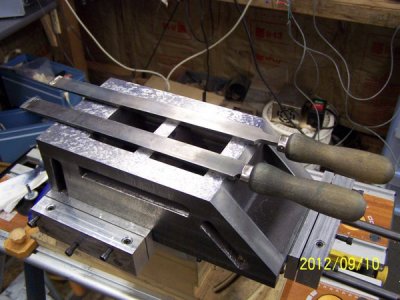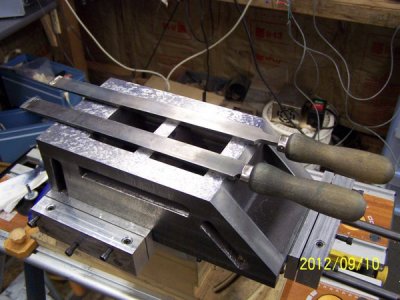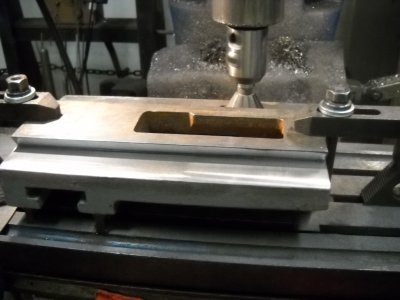-
Welcome back Guest! Did you know you can mentor other members here at H-M? If not, please check out our Relaunch of Hobby Machinist Mentoring Program!
You are using an out of date browser. It may not display this or other websites correctly.
You should upgrade or use an alternative browser.
You should upgrade or use an alternative browser.
VIDEO: Scraping in a lathe's top slide (with tapered gib)
- Thread starter HMF
- Start date
So, when you are scraping, are you only scraping the the (raised) sections that have the blue dykem on them? Cause it looks like you are just sort of randomly picking spots to scrape in the video, but somehow you end up with a very uniform surface. (warning: I have zero knowledge of how scraping is done, but I would really like to learn). And then going back and forth with the test and scraping until you get a uniform blue?
While you are scraping, how do you know how deep to dig with the scraper, so that you aren't just creating bigger issues? Or the scraper sort of self-limiting in how deep it will scrape at a given point?
While you are scraping, how do you know how deep to dig with the scraper, so that you aren't just creating bigger issues? Or the scraper sort of self-limiting in how deep it will scrape at a given point?
- Joined
- Feb 2, 2013
- Messages
- 3,916
i'm fascinated by the video and the scraping process. until about a year ago i had not known of the process.
i'll be interested to find out more about it!
thanks for the post!
:man:
i'll be interested to find out more about it!
thanks for the post!
:man:
4
4GSR
Forum Guest
Register Today
- Joined
- Jun 26, 2012
- Messages
- 76
JayChris
The video is using a Biax power scraper and is an advanced technic. You can very the speed and stroke of the scraper.
When hand scraping you want to only remove the high spots and leave the low spots. You are shooting to get the high spots equal to the low spots. Generally speaking when hand scraping you are removing between .0002" and .0005" depending on how much pressure you apply to the scraper. You try and be consistent with your pressure.
As you continue to scrap to a known flat surface you strive to get more points per square inch (PPI) and percentage of points (POP). Machine ways shoot for 20PPI and 40%POP. For reference surfaces like you saw in the video you shoot for 40PPI and 40POP
As Richard is fond of saying any one can scrape, it just takes time to learn what the bluing is telling you and not chase you tail. Scraping takes a lot of time and can be hard on the back and arms.
Dave
A shot of my hand scrapers and a sub table for my milling machine I was scraping.


The video is using a Biax power scraper and is an advanced technic. You can very the speed and stroke of the scraper.
When hand scraping you want to only remove the high spots and leave the low spots. You are shooting to get the high spots equal to the low spots. Generally speaking when hand scraping you are removing between .0002" and .0005" depending on how much pressure you apply to the scraper. You try and be consistent with your pressure.
As you continue to scrap to a known flat surface you strive to get more points per square inch (PPI) and percentage of points (POP). Machine ways shoot for 20PPI and 40%POP. For reference surfaces like you saw in the video you shoot for 40PPI and 40POP
As Richard is fond of saying any one can scrape, it just takes time to learn what the bluing is telling you and not chase you tail. Scraping takes a lot of time and can be hard on the back and arms.
Dave
A shot of my hand scrapers and a sub table for my milling machine I was scraping.


- Joined
- Jul 1, 2012
- Messages
- 1,356
Thanks Dave for helping...I will make this short for now as I am on a crise ship and paying .047 a min.
To be honest the scraping the guy is doing on the video is not the best, as he is going up and down with the Biax scraper and digging deep holes, scraping one time back and forth of the power scraper removes .0001 to .0002" and it looks like the machine is running at about 600 strokes per min, so he is digging a hole going up and down. Probably .001 to .002" deep I would suspect. We move the scraper sideways as Dave says and get indivual marks to duplicate the hand scraping prodecure. That method is what we sort of do when we rough scrape (Circles as I show in my classes and video). He also does not check for the "rotation" of poits to see where the fulcrum points are it should pivot about 30% from each end. Maybe Dave or Tadd can help explain that to you.
Percentage should be 50% or 40 to 60% as you want as many low spots as high or rubbing spots (weight carrying) so oil is distributed evenly on the way "bearing" Think about a ball bearing. The ball and then the gease or oil to help it roll and stay lubricated. We call it "way bearing". Some manufactures use 12 points as the best "contact" points needed. I have always been able to scrape 20 as once you learn the proper techniques 20 PPI is easy. But you beginners should get as many as possible now. 5 is better the nothing. If any of you have ever use gage or joe blocks and you rub them together, they "ring" or the friction makes them stick because the have 100% contact. We want no more the 50% remember because we need oil. The ship yeards and electric power plants scrape turbaine housings or steam nozel seats to 90 to 100% contact so steam doesn't escape. If you have 90% contact on a "way bearing" it will start to lape together and you will see scratches and it will begine to gull up.
1/2 moon flake removes about 50% of the metal and the depth is on average .002" (to deep for scraping and exposed surface). That is why some machines are ground and flaked.
OK thats it for now. Thanks Dave for your help. Hopefull some day you all will help each other when I have gone to the happy scaping land....LOL...in 20+ years I hope.
I am on the way back home on the ship...to snow and cold....yuck.......
Have a great weekend.
Rich
PS no editing this time or spell check....lol
To be honest the scraping the guy is doing on the video is not the best, as he is going up and down with the Biax scraper and digging deep holes, scraping one time back and forth of the power scraper removes .0001 to .0002" and it looks like the machine is running at about 600 strokes per min, so he is digging a hole going up and down. Probably .001 to .002" deep I would suspect. We move the scraper sideways as Dave says and get indivual marks to duplicate the hand scraping prodecure. That method is what we sort of do when we rough scrape (Circles as I show in my classes and video). He also does not check for the "rotation" of poits to see where the fulcrum points are it should pivot about 30% from each end. Maybe Dave or Tadd can help explain that to you.
Percentage should be 50% or 40 to 60% as you want as many low spots as high or rubbing spots (weight carrying) so oil is distributed evenly on the way "bearing" Think about a ball bearing. The ball and then the gease or oil to help it roll and stay lubricated. We call it "way bearing". Some manufactures use 12 points as the best "contact" points needed. I have always been able to scrape 20 as once you learn the proper techniques 20 PPI is easy. But you beginners should get as many as possible now. 5 is better the nothing. If any of you have ever use gage or joe blocks and you rub them together, they "ring" or the friction makes them stick because the have 100% contact. We want no more the 50% remember because we need oil. The ship yeards and electric power plants scrape turbaine housings or steam nozel seats to 90 to 100% contact so steam doesn't escape. If you have 90% contact on a "way bearing" it will start to lape together and you will see scratches and it will begine to gull up.
1/2 moon flake removes about 50% of the metal and the depth is on average .002" (to deep for scraping and exposed surface). That is why some machines are ground and flaked.
OK thats it for now. Thanks Dave for your help. Hopefull some day you all will help each other when I have gone to the happy scaping land....LOL...in 20+ years I hope.
I am on the way back home on the ship...to snow and cold....yuck.......
Have a great weekend.
Rich
PS no editing this time or spell check....lol
4
4GSR
Forum Guest
Register Today
I sure hope Rich is not stuck on that ship being towed back to port???

